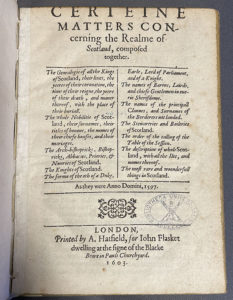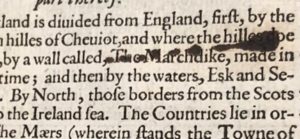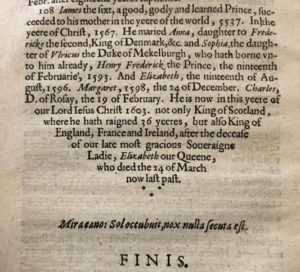Certeine matters concerning the realme of Scotland (1603)
We are delighted that students on Dr Amy Blakeway’s ‘Mary Queen of Scots, France, England and Ireland’ module (MO4807) have once again submitted blog posts as part of their course. Here is the next part of a series of blogs which reflect on the rare books with which the students engaged during their studies.
When James VI of Scotland became James I of England after the death of Elizabeth I, knowledge of Scotland would have been in high demand by the English who did not know anything about the northern realm. This was the purpose of the book Certeine matters concerning the realme of Scotland. Published in London in 1603, it can be assumed that the audience was intended to be English, with the purpose of educating them about their new king and the country from which he came. Although the author is not known for sure, John Monipennie has had this work attributed to him since he is believed to be the writer of the original 1594 version named Certaine matters composed together.


Certeine matters is a pocket-size book with an undecorated modern binding giving it a plain appearance. Its small size would allow for quicker production, faster sales, and wider circulation, and it would have been produced cheaply, making it affordable to more people. The text block has been heavily trimmed, with the title itself affected. This suggests that it has been rebound at least once, and this copy was clearly used by contemporary readers. This is clear through the ink spillages on several pages and the annotations which begin to appear in the later half of the book, revealing that at least one reader was engaged with this work. Despite the occasional spillage, the book appears to be in a relatively good condition considering its age!

Historians who have studied this book have often divided the contents into three rough sections including a chronology of the Scottish monarchy, details about the Scottish elites, and lastly the description of Scotland’s landscape and wonders. The first section that lists Scotland’s past monarchs used Hector Boece’s History of Scotland as a source of information. Boece was a very inspiring and renowned Scottish historian, philosopher, and scholar in his time, so it is not surprising that his work has influenced Certeine matters. However, Boece’s History was published in 1527 which meant that Mary Queen of Scots and James VI were not included in his royal chronology and so Monipennie has made these additions himself. One of the biggest differences between the 1603 and 1594 editions is the descriptions given to Mary and James. The earlier edition described Mary’s life in much more detail, including information such as her marriage to Bothwell which is missing from the 1603 version, whilst James is named the King of England, Ireland and France, an essential update for the new publication.
The ending of King James’ description mentions the death of Elizabeth in a very respectful manner by calling her “our late moft gracious Soueraigne Ladie”. This again shows that the intended audience was the English since they have honoured Elizabeth within this Scottish text. Additionally, Elizabeth is described as “our” Queen which could suggest that the printer in London added the praiseful description, as Monipennie was Scottish and would have been unlikely to have referred to Elizabeth in this way.

Although this book was used to educate James’ new English subjects about Scotland, it also allowed the Scots to assert the longevity of their monarchy and to demonstrate their historical and continuing independence from England. Therefore, Certeine matters was also used to remind the English that Scotland was a legitimate, independent nation and not one ruled by England.
Caitlin Stewart
Bibliography
Primary Sources
Monipennie, John, Certeine matters concerning the realme of Scotland, composed together: the genealogie of all the kings of Scotland, their liues, the yeeres of their coronation, the time of their reigne, the yeere of their death, and maner thereof, with the place of their buriall : the whol nobilitie of Scotland, their surnames, their titles of honour, the names of their chiefe houses, and their mariages : the arch-bishopricks, bishopricks, abbacies, priories, & nunries of Scotland : the knights of Scotland : the forme of the oth of a duke, earle, lord of Parliament, and of a knight : the names of barons, lairds, and chiefe gentlemen in euerie sherifdome : the names of the principall clannes, and surnames of the borderers not landed : the stewartries and baileries of Scotland : the order of the calling of the Table of the Session : the description of whole Scotland, with all the iles, and names thereof : the most rare and woonderfull things in Scotland : as they were anno Domini, 1597 (London, 1603).
Secondary Sources
Mason, Roger A., ‘1603: Multiple Monarchy and Scottish Identity’, History, 105: 366 (2020), pp. 402-421.
Mason, Roger A., ‘Certeine Matters Concerning the Realme of Scotland: George Buchanan and Scottish Self-Fashioning at the Union of the Crowns’, The Scottish Historical Review, 1: 233 (2013), pp. 38-65.